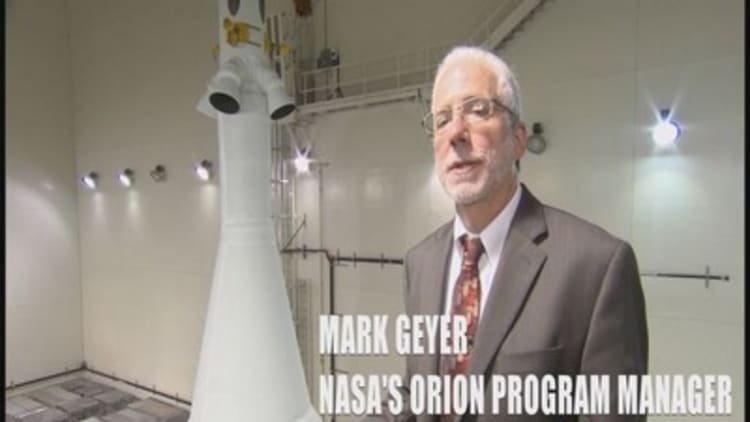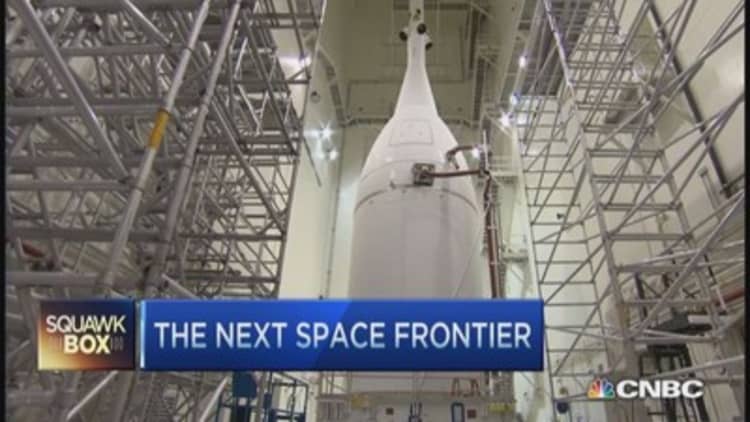
If all goes according to plan, a capsule designed to carry humans will rocket up from Florida at 7:05 a.m. ET on Thursday, and go higher than any such craft has flown in more than 40 years.
"Tomorrow is giant. It's a huge day for us," said NASA Administrator Charles Bolden, a former astronaut. Standing in front of the Orion spacecraft sitting atop a powerful Delta IV rocket, together stretching 240 feet into the sky, Bolden told a crowd of international media, "I've become accustomed to saying it's a 'BFD.' If you don't know what that is, then I'll let somebody else explain it to you."
How big is this deal? The Orion is the biggest bet on getting humans to Mars. Thursday's unmanned test flight will send Orion 3,600 miles up into space, 15 times higher than the International Space Station, to test the riskiest parts of the craft—a new launch abort system, computers being subjected to high levels of radiation, the largest heat shield ever made, a parachute system that will have to slow Orion from 20,000 mph to zero in 11 minutes, and a new manner of ocean recovery being handled by the U.S. Navy.
A lot of the pressure sits on the shoulders of Mike Hawes, Orion program manager for Lockheed Martin. In a twist, Lockheed, which built the Orion, will be running the test. NASA will have a secondary though essential position.
Lockheed contracted with the United Launch Alliance for the rocket, and with nongovernmental entities in charge, ULA and Lockheed had to get Federal Aviation Administration licenses for both the launch and re-entry.
Read More
"There's a few final software changes that we've done," said Hawes.
While he is confident in the program, he doesn't expect to get much sleep Wednesday night.
"We know it's likely that something will go wrong," Hawes said.
That's the point of the test—to stress the riskiest parts of Orion while it is unmanned. "I'll be shocked if everything works perfectly on the spacecraft," he said.
He's particularly concerned about how computer systems will fare going through the earth's Van Allen radiation belt, as computer systems now "are more susceptible to radiation than those on Apollo."

Here is a rundown of events, assuming the weather cooperates. As of Wednesday afternoon, the mission had a 70 percent chance of launching on time.
- 1 a.m. ET: Power up Orion. One final systems check.
- 2:30 a.m.: Fueling begins
- 7:05 a.m.: Liftoff, though the launch window lasts until 9:44 a.m.
- United Launch Alliance says 82 seconds after liftoff, the Delta rocket with three boosters will be traveling at Mach 1, experiencing "maximum dynamic pressure"
- Three minutes and 28 seconds after liftoff, the two outer liquid core boosters separate. The main booster will power Orion upward going 13,474 mph. (This is the part Hawes is most nervous about, getting Orion to the right spot.)
- Five and a half minutes after liftoff: first stage jettisons, main engine cutoff. Second stage ignites.
- About 30 seconds later: the service module "fairings" and launch abort system jettison.
- A little over seven minutes after liftoff: Orion begins first orbit around earth.
- Two hours into the mission, the second stage reignites, raising Orion's orbit during its second trip around the Earth to 3,600 miles above the surface.
- Three and a half hours into the mission, Orion will pass through the Van Allen radiation belt and prepare for its high-speed re-entry. "Then begins Orion's trial by fire," as it reaches speeds of 20,000 mph.
- Four hours and 15 minutes in, Orion hits the Earth's atmosphere.
- Five minutes later, the cover for the parachutes is jettisoned, and the chutes deploy.
- Five minutes after that, Orion will splash down hundreds of miles off the coast of Baja, California.
NASA will keep the craft powered for an hour after splashdown to measure how much heat from the new shield soaks back into Orion's interior. After reviewing the data and assessing safety, two Navy choppers will mark the landing site with smoke, and six small Navy vessels will move in to recover the craft. Ideally, it will be towed into the flooded well deck of the USS Anchorage. The whole recovery process will take six hours.
The cost of Thursday's launch is being put at around $370 million, though the entire program has so far cost more than $5 billion. A second unmanned test is planned for 2017 or 2018 to send the craft around the moon. In 2021, astronauts will be put on board. NASA hopes to get to Mars in the mid-2030's.
There will be international partners along the way. Airbus will construct the service module, which will be a final part of the spacecraft.
Read MoreThe next wildfire could be fought by a drone
"We don't do everything better than everybody else, as much as I'd like to think that," said Bolden. However, "It is really important for the U.S. to step up and admit that we are the leader in the world when it comes to exploration of space ... if we didn't want to go to Mars, then we shouldn't have done Apollo."
It's hard to describe the excitement in the space community, despite the disasters on the commercial side in October. Gene Kranz, the flight director for Apollo 11 and Apollo 13, will be a VIP guest at Johnson Space Center's Mission Control.
Looking out on the causeway at Cape Canaveral, Bolden fought for control of his emotions, "I hope this is reminiscent for people who are old enough to know of the early days of the Shuttle, when there were flags from nations from all over the world ... it's a big day."


